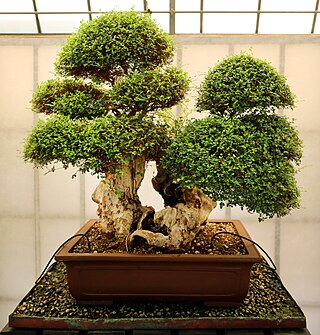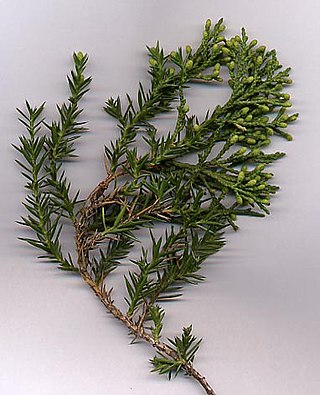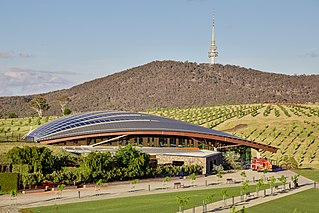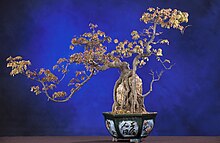
Bonsai is the Japanese and East Asian art of growing and training miniature trees in containers, developed from the traditional Chinese art form of penjing . Penjing and bonsai differ in that the former attempts to display "wilder," more naturalistic scenes, often representing landscapes, including elements such as water, rocks, or figurines; on the other hand, bonsai typically focuses on a single tree or a group of trees of the same species, with a higher level of aesthetic refinement. Similar versions of the art exist in other cultures, including the miniature living landscapes of Vietnamese Hòn non bộ. During the Tang dynasty, when penjing was at its height, the art was first introduced in China.
The Huntington Library, Art Museum and Botanical Gardens, known as The Huntington, is a collections-based educational and research institution established by Henry E. Huntington and Arabella Huntington in San Marino, California. In addition to the library, the institution houses an extensive art collection with a focus on 18th and 19th century European art and 17th to mid-20th century American art. The property also has approximately 120 acres (49 ha) of specialized botanical landscaped gardens, including the "Japanese Garden", the "Desert Garden", and the "Chinese Garden".

Taxodium mucronatum, commonly known as Montezuma bald cypress, Montezuma cypress, or ahuehuete, is a species of Taxodium that is primarily native to Mexico and Guatemala, with a few populations in the southwestern United States. Ahuehuete is derived from the Nahuatl name for the tree, āhuēhuētl, which means "upright drum in water" or "old man of the water."

Juniperus chinensis, the Chinese juniper is a species of plant in the cypress family Cupressaceae, native to China, Myanmar, Japan, Korea and the Russian Far East. Growing 1–20 metres tall, it is a very variable coniferous evergreen tree or shrub.

Penjing, also known as penzai, is the ancient Chinese art of depicting artistically formed trees, other plants, and landscapes in miniature.

The United States National Arboretum is an arboretum in northeast Washington, D.C., operated by the United States Department of Agriculture's Agricultural Research Service. It was established in 1927 by an act of Congress after a campaign by USDA Chief Botanist Frederick Vernon Coville.

Gongshi, also known as scholar's rocks or viewing stones, are naturally occurring or shaped rocks which are traditionally appreciated by Chinese scholars. The term is related to the Korean suseok (수석) and the Japanese suiseki (水石).

Heathcote Botanical Gardens is a five-acre subtropical botanical garden located at 210 Savannah Road, Fort Pierce, Florida, United States.

John Yoshio Naka was an American horticulturist, teacher, author, and master bonsai cultivator.

In traditional Japanese culture, suiseki (水石) are small naturally occurring or shaped rocks which are appreciated for their aesthetic or decorative value. They are similar to Chinese scholar's rocks.

A moon gate is a circular opening in a garden wall that acts as a pedestrian passageway and is a traditional architectural element in Chinese gardens. The gates serve as an inviting entrance into the gardens of the rich upper class in China.

Tiger Hill is a hill in Suzhou, China. It is a tourist destination that is known for its natural environment and historic sites. The hill's name is said to come from the fact it looks like a crouching tiger. Another legend states that a white tiger appeared on the hill to guard it following the burial of King Helü. The hill is also sometimes referred to in parallel with Lion Mountain, another hill in Suzhou which resembles a sitting lion.

Saikei (栽景) literally translates as "planted landscape". Saikei is a descendant of the Japanese arts of bonsai, bonseki, and bonkei, and is related less directly to similar miniature-landscape arts like the Chinese penjing and the Vietnamese hòn non bộ. It is the art of creating tray landscapes that combine miniature living trees with soil, rocks, water, and related vegetation in a single tray or similar container. A saikei landscape will remind the viewer of a natural location through its overall topography, choice of ground materials, and the species used in its plantings.

The Larz Anderson Bonsai Collection at the Arnold Arboretum in Jamaica Plain, Massachusetts is one of the premier collections of bonsai in the United States and includes a Hinoki Cypress over 250 years old.

Goshin is a bonsai created by John Y. Naka. It is a forest planting of eleven Foemina junipers, the earliest of which Naka began training into bonsai in 1948. Naka donated it to the National Bonsai Foundation in 1984, to be displayed at the United States National Arboretum; it has been there ever since. The individual trees represent Naka's grandchildren.
Wu Yee-sun was a Hong Kong entrepreneur and billionaire who founded the Wing Lung Bank.

The National Arboretum Canberra is a 250-hectare (620-acre) arboretum in Canberra, the national capital of Australia, created after the area was burned out as a result of the Christmas 2001 and 2003 Canberra bushfires: The Himalayan Cedar forest lost about one third of its trees, and the commercial Radiata Pine plantation was burned out, allowing the arboretum to be created.
Yuji Yoshimura was a second-generation distinguished bonsai master who taught traditional Japanese techniques and aesthetics to enthusiasts in the West.
William N. Valavanis, is a Greek-American bonsai master who carries on Yuji Yoshimura's tradition of teaching Japanese techniques and aesthetics to enthusiasts in the West.

Bonsai is a Japanese art form using trees grown in containers. Similar practices exist in other cultures, including the Chinese tradition of penjing from which the art originated, and the miniature living landscapes of Vietnamese hòn non bộ. The term "bonsai" itself is a Japanese pronunciation of the earlier Chinese term penzai. The word bonsai is often used in English as an umbrella term for all miniature trees in containers or pots. This article focuses on the history of bonsai in Japan and, in modern times, worldwide.
























